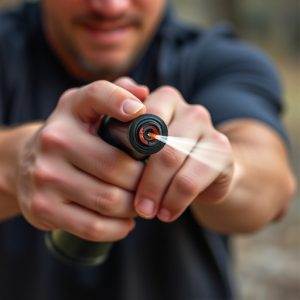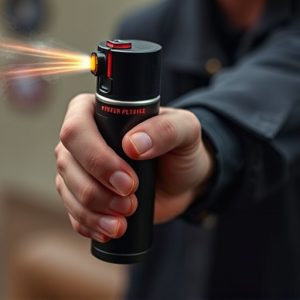Pepper Spray Defense: Training, Choices, and Legalities for Civil Protection
Pepper spray, a popular self-defense tool, uses capsaicin from chili peppers to disable attackers te…….
Pepper spray, a popular self-defense tool, uses capsaicin from chili peppers to disable attackers temporarily. Effective use requires training in techniques like deployment distance, aiming, and understanding spray types. Understanding local laws regarding pepper spray is crucial before purchase or use. Regular practice sessions, defense training programs, and proper storage are key elements of responsible pepper spray ownership for personal safety.
In today’s uncertain times, civilian protection through defensive spray has emerged as a powerful tool for personal safety. This comprehensive guide explores the world of pepper spray, from understanding its active ingredients and safety measures to navigating legal considerations and choosing the right product. We’ll delve into effective use techniques, offering training tips for optimal defense, and discuss responsible ownership practices to ensure safety beyond the incident. Get ready to empower yourself with knowledge on pepper spray defense training tips.
- Understanding Pepper Spray: The Basics of Active Ingredients and Safety
- Legal Considerations: Know Your Rights and Local Regulations for Self-Defense Spray
- Choosing the Right Pepper Spray for Personal Protection: Factors to Consider
- Effective Use Techniques: Training Tips for Optimal Defense When Facing Threats
- Responsible Ownership and Storage Practices: Ensuring Safety Beyond the Spray Incident
Understanding Pepper Spray: The Basics of Active Ingredients and Safety
Pepper spray is a non-lethal self-defense tool that has become increasingly popular among civilians seeking protection. At its core, pepper spray works by causing irritation and temporary blindness to the eyes and respiratory system of the target. The active ingredient in most pepper sprays is capsaicin, derived from chili peppers. This compound triggers nerve endings, leading to a burning sensation and a strong reaction that can disable an attacker for a crucial period, allowing the user to escape or seek help.
When using pepper spray, safety is paramount. It’s essential to understand that while it’s an effective deterrent, it should be used responsibly. Proper training in pepper spray defense techniques is key. This includes learning the right distance to deploy the spray, knowing how to aim for maximum impact, and understanding the different types of sprays available. With proper knowledge and practice, individuals can enhance their personal safety without endangering themselves or others.
Legal Considerations: Know Your Rights and Local Regulations for Self-Defense Spray
When considering a pepper spray defense for personal protection, it’s crucial to understand the legal landscape surrounding self-defense tools in your area. Different regions have varying laws and regulations regarding civilian use of pepper spray, so knowing your rights is essential before making a purchase. Many jurisdictions allow the carrying of pepper spray for self-defense purposes, but specific restrictions apply, such as permitted amounts, age limitations, and registration requirements.
Before you invest in a pepper spray defense system, conduct thorough research on local laws and consider attending Pepper Spray Defense Training Tips workshops to ensure compliance. These sessions often provide insights into the most recent regulations and offer practical guidance on when and how to deploy such tools responsibly. Understanding your rights and responsibilities will help you stay within legal boundaries while protecting yourself effectively.
Choosing the Right Pepper Spray for Personal Protection: Factors to Consider
When considering pepper spray for personal protection, it’s crucial to select a product that aligns with your specific needs and training level. Factors like occlusiveness (how well the spray blocks vision), range, and active ingredients determine its effectiveness. Opt for a can with a good spray pattern and sufficient reach to create distance from potential threats.
Training tips also play a vital role in responsible usage. Familiarize yourself with local laws regarding pepper spray possession and use. Practice target practice to ensure accurate deployment under stress. Additionally, understand wind conditions, as these impact the spray’s direction and effectiveness. Regularly update your skills through defense training programs to make informed decisions when facing dangerous situations.
Effective Use Techniques: Training Tips for Optimal Defense When Facing Threats
When it comes to pepper spray defense, proper training is paramount to ensure its effective use in threatening situations. Effective deployment involves more than just carrying a can; it’s about understanding and practicing specific techniques that maximize its power as a self-defense tool. Pepper spray defense training tips include learning proper aiming, distance considerations, and the use of different holding techniques.
Regular practice sessions are crucial to build muscle memory for these techniques. Simulating real-life scenarios allows users to experience the spray’s effects firsthand, helping them gauge distance and visualize clear paths for escape. Additionally, understanding when and how to deploy pepper spray defensively can make all the difference in disarming or deterring potential assailants. Training also provides an opportunity to address common mistakes and misperceptions about its use, ensuring citizens are equipped with the knowledge to protect themselves effectively.
Responsible Ownership and Storage Practices: Ensuring Safety Beyond the Spray Incident
Responsible ownership and proper storage practices are integral aspects of using pepper spray for civilian protection. It’s not just about knowing how to deploy the spray during an encounter; it’s equally important to understand the safety measures that prevent accidental discharge, misuse, or access by unauthorized individuals. Pepper spray defense training tips emphasize the need for secure storage options like locked cabinets or safes, keeping the spray out of sight and reach of children and curious minds. Regularly updating and following safety guidelines from reputable manufacturers is crucial.
Moreover, responsible ownership involves staying informed about local laws regarding pepper spray possession and usage, ensuring compliance to avoid legal repercussions. Storing spare units separately and maintaining an up-to-date inventory can aid in preventing accidental use or loss. These practices contribute to a safer environment not just during immediate protection needs but also in the broader context of responsible civilian armament.
Pepper spray has emerged as a powerful tool for civilian self-defense, offering individuals a means of protecting themselves against potential threats. By understanding the basics of its active ingredients, legal considerations, and effective use techniques, users can make informed decisions when choosing the right pepper spray for their needs. Responsible ownership practices ensure safety not only during incidents but also beyond them. With proper training tips, civilians armed with pepper spray can gain valuable skills to defend themselves confidently in various situations, empowering them to stay safe in today’s world.


